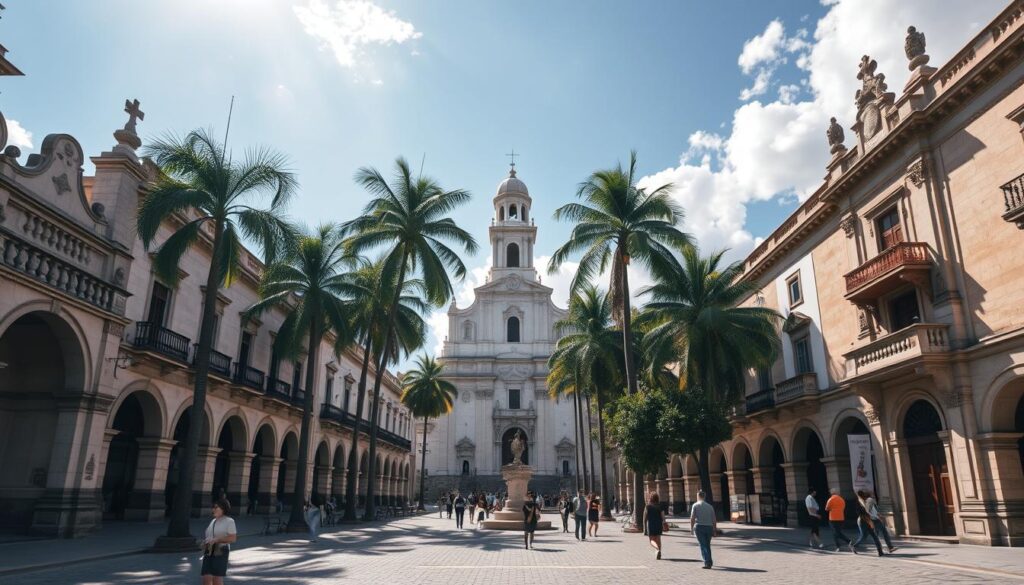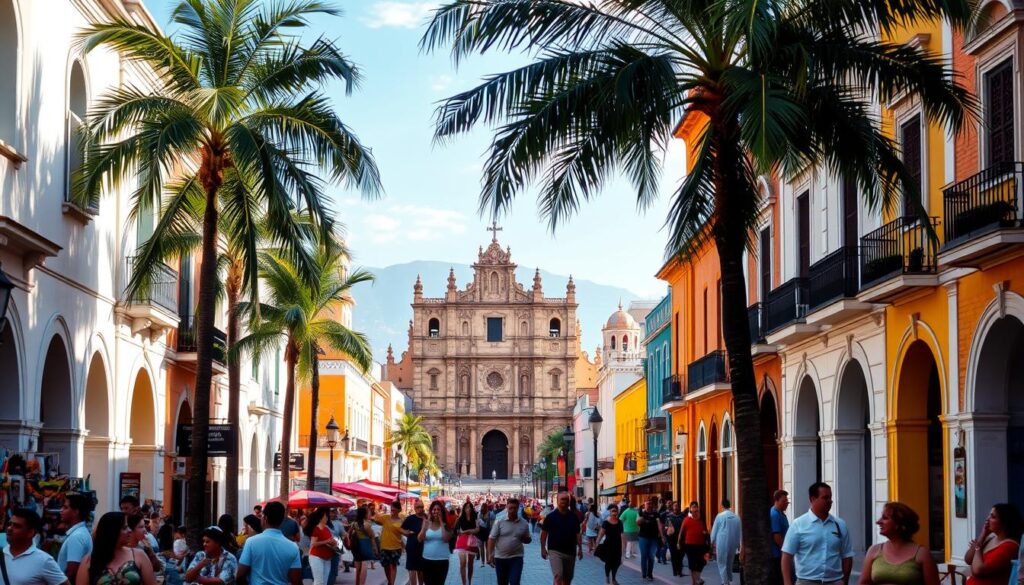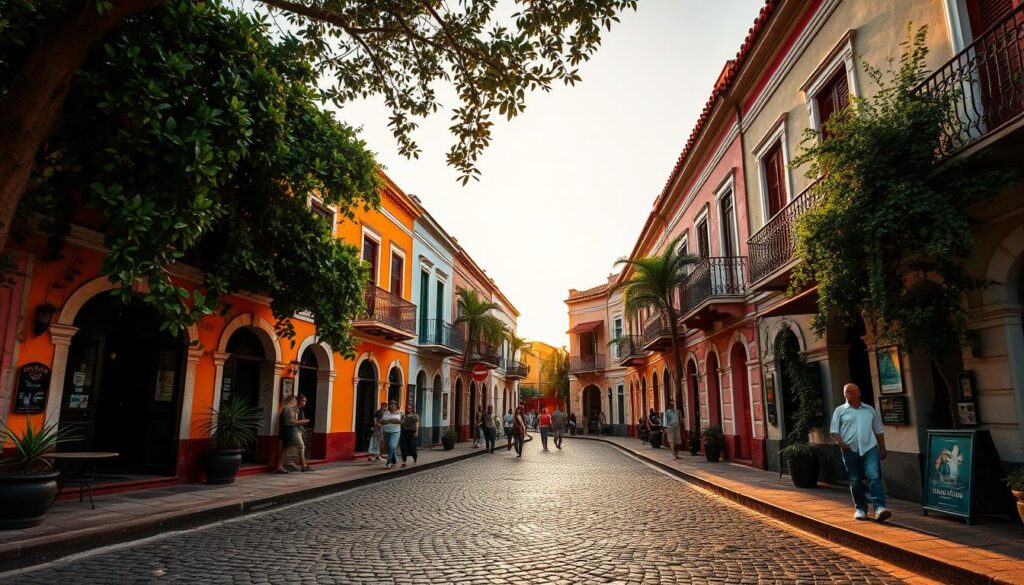Historic Mérida contains more than sixty percent of its buildings which originated from the 16th and 17th centuries. This exciting city in the Yucatán Peninsula serves as an active historical and cultural monument. The city gains its “La Ciudad Blanca” nickname from its white limestone construction while preserving European and indigenous heritage elements that define its character.
Spanish conquistadors established the city at these Mayan ruins in 1542 before it became the noteworthy destination it is today. Visitors find historical narratives embedded in the luxurious architecture that decorates every street of this location. Every aspect of this region presents itself in its rich heritage through magnificent cathedrals and delightful plazas.
This piece will explore Mérida’s historical growth in two parts by revealing its architectural history and cultural development patterns. The article reveals essential landmarks together with conservation information that shows how this urban center maintains its historical value along with contemporary development. Preparations are underway to reveal Mérida’s everlasting allure.
Key Takeaways
- Mérida gains its nickname of “La Ciudad Blanca” because its buildings are constructed from white limestone.
- Spanish explorers established the settlement in 1542 by constructing it on top of Mayan archaeological sites.
- The city combines structures that show the connection between European and local indigenous design styles.
- History reveals that more than sixty percent of the buildings in the historic district existed during the 16th and 17th centuries.
- The following article examines the landmarks of Mérida as well as its preservation work and historical process of cultural adaptation.
- Introduction to Mérida’s Colonial Legacy
The historical origins of Mérida appear throughout every aspect of its urban fabric. The entire lively city area shares narratives about cultural coexistence and artistic development throughout history. The city maintains its current appeal through distinctive cultural mixtures which started when it was founded in the sixteenth century.
Overview of Mérida’s Architectural Heritage
Building architecture in the city shows simultaneous influence of Renaissance, Baroque and indigenous Mayan architectural traditions. Francisco de Montejo ensured the foundation of the city by channeling his influence to create its distinctive character. The San Ildefonso Cathedral serves alongside other buildings as evidence of the extensive cultural history of the area.
These historical buildings serve as objects from past times. Architectural heritage exists as actual representatives of cultural history through which design has progressed since ancient times. The city demonstrates its survival throughout different periods of time with its blending architectural traditions.
Cultural Significance of the White City
The architectural features of Mérida represent something greater than their visual appeal. The city’s architectural visual represents both how Merida remains standing and reflects its cultural determination. Through the integration of local building methods the structure becomes enriched with historical backgrounds.
Preserving these structures is crucial. These monuments function as historical reminders to provide continuity between past times and contemporary development of the city. Protective efforts directed towards these buildings guarantee their visual appeal and historical importance will be available for future appreciation.
Historical Background of Mérida’s Colonial Architecture
The roots of Mérida’s design trace back to a blend of Spanish and indigenous cultures. The cultural blend produced a distinctive urban style which remains breathtaking to visitors at present. The innovations of early times along with evolving adaptations shaped Mérida’s future identity that lasted throughout hundreds of years.
Foundations and Early Influences
Spanish conquistadors chose to establish Mérida on top of Maya ruins which proved historically advantageous in the area. The settlement decision enabled frontier operations at the city while merging European and indigenous lifestyle practices. Local limestone adoption as a construction material became the fundamental characteristic of its architectural style.
New design trends from the Spanish Renaissance met Baroque characteristics to form distinctive structures suiting Yucatan climate conditions. The city showed its growing wealth through its elaborate outer displays and its noble building styles. The built architecture both looked good and worked well for the weather conditions and local resource availability of the region.
Several important historical events throughout time have established the characteristics of the city.
Several historical developments influenced the character of urban development in Mérida. The city began to grow because the Spanish created it in the 16th century. The rise of henequen commercialization in the 19th century created wealth that led to the building of memorable residential homes and public institutions.
The historic buildings from past years have maintained their impact on the current urban space as they depict the region’s cultural background. Maintaining these historic landmarks by preservation activities ensures Mérida combines its cultural legacy with contemporary development.
| Event | Impact |
|---|---|
| 1542: City Founding | Established on Maya ruins, blending cultures. |
| 16th-17th Century: Spanish Influence | Introduction of Renaissance and Baroque styles. |
| 19th Century: Henequen Boom | Wealth led to construction of grand buildings. |
Colonial Architecture of Mérida: Yucatán’s White City
Visually the city draws attention due to the detailed architectural designs which use everlasting materials as construction elements. All these buildings stand as artistic achievements of the builders who established them. Every façade showcases a combination of intricate carvings with dazzling decorative elements that please the view of onlookers.
Distinctive Façade and Ornamentation
These walls function beyond structural purpose because they serve as cultural output. The architectural significance emerges from European elements and local design aspects which carvers elaborate through beautiful details. The extensive time and craftsmanship of born artisans became visible through these decorative designs.
Façade elements in various buildings display flower symbols with geometric decorations as well as sacred symbols. These ornamental elements share vital information about the customs and faith of the builders from the past. The city’s exclusive identity emerges from every single component which adorns its structures.
Building construction in Lijiang uses local materials as its primary building material.
Local limestone stands as the essential material in constructing urban structures throughout the city. The white color of the limestone materials creates the distinctive appearance of the downtown buildings. For practical aesthetics the builders selected this material because of its availability alongside its durable nature. Jobsite and the people share a shared identity through the strategic choice of limestone as construction material._ The creative builders demonstrated their ability to transform European building styles by making them work with local requirements. The innovative combination between different building methods results in a continuous link between the past and present.

Iconic Colonial Landmarks in Mérida
The city offers an authentic opportunity to experience historical past through its landmark monuments. The structures represent more than structures because they exist as authentic living memorials to historical times. Various sites throughout the city use their grand cathedrals and historical mansions to display cultural pride through artistic masterpieces from the past.
| Landmark | Key Features |
|---|---|
| San Ildefonso Cathedral | Oldest cathedral in the Americas, Renaissance and Baroque styles, religious art. |
| Casa de Montejo | Ornate façade, cultural center, historical significance. |
| Government Palace | Historic murals, public gatherings, symbol of authority. |
San Ildefonso Cathedral: A Testament to History
The San Ildefonso Cathedral rests where historic ruins previously existed to become one of the oldest Christian buildings in the Western Hemisphere. The vast exterior of the building along with its elegant ornamentation displays Renaissance and Baroque design elements. The cathedral contains magnificent artwork and devout religious artifacts which showcase centuries worth of spiritual dedication.
This landmark continuously attracts masses of people who want to experience its historical significance and observe its attractive design. This sacred building acts as a key component in neighborhood festivals thus playing an active role in tying together the community spirit. The institution functions as a religious-temporal destination that joins historic times to modern periods.
Casa de Montejo and the Government Palace
The founder of the city still lives in Casa de Montejo which showcases exceptional colonial design. The exterior design of this building consists of elaborately carved details combined with symbolic artistic designs. The structure operates now as a cultural center that shows historical details about the early period of the city.
The Government Palace serves both as a heritage symbol and a symbol of authority right next to its location. The building showcases important historical events of the region through its mural art transforming it into a living historical monument. The twain buildings attract public events and create joyful vibrancy for the entire neighborhood area.
Through their eternal beauty both landmarks provide continuous links between past and present generation of the city.
The landmarks offer more value than ordinary visitor destinations. They represent the living pulse of the city because historical value merges with artistic treasures. Viewing the neighborhood or studying the unique features at these sites allows visitors to understand how traditions interact with the passage of time.
Mérida’s Cultural Identity Through Its Architecture
The exclusive personality of Mérida emerges from how it connects historical elements with contemporary society. Historic buildings in the city serve as ceremonial representations of cultural preservation as well as national heritage.
Preservation Efforts and Urban Development
During modern times Mérida dedicates considerable funds towards renewing its historic residential districts. The main objective of restoration projects consists of upholding important heritage sites through urban development programs. The city maintains its charm through these conservation projects during its expansion period.
These historic landmarks need protection which multiple community organizations together with governmental institutions provide. The protection of architectural heritage in the city gets support from both local organizations and authorities. The cultural heritage preservation mission of Mérida receives dedicated support through this combined community and government initiative.
Local stone remains in use across the city to connect historic values with modern times. These materials provide long-term strength to the structures and simultaneously showcase the local resource management capabilities. The combination of traditional construction practices with contemporary techniques allows the city to continue its historic cultural pattern.
Global acknowledgment of Mérida has improved because of preservation initiatives that have taken place. Both historians and tourists visit the city because it successfully combines progress with preservation of its historical sites. The equilibrium between modernity and heritage protection makes Mérida serve as the benchmark for urban centers that plan to safeguard their historical importance.
These initiatives demonstrate how Mérida honors its past while embracing the future. By preserving its architectural treasures, the city ensures that its cultural identity remains vibrant and relevant in the modern world.

Impact of Colonial Heritage on Local Tourism
The blend of history and culture in this vibrant destination draws travelers from across the globe. Its colonial legacy is a magnet for visitors seeking to explore its timeless charm. From interactive tours to lively festivals, the city offers a dynamic experience that brings its past to life.
Modern Revitalization of Historical Districts
Revitalized neighborhoods are a prime example of how the city merges historic charm with modern amenities. Areas like the historic center have been transformed into hubs of activity, offering cafes, shops, and cultural spaces. These districts not only preserve the past but also cater to contemporary needs.
Interactive experiences at landmarks, museums, and temples enrich the visitor journey. Guided tours often include storytelling and hands-on activities, making history accessible and engaging. This approach ensures that every visit is both educational and memorable.
Music and cultural events held in these districts breathe life into the city’s colonial past. Festivals often feature traditional performances, creating a vibrant atmosphere that connects visitors with local traditions. These events are a fact of the city’s cultural richness and appeal.
Safety and immersion are key factors in the city’s tourism success. Visitors often praise the welcoming atmosphere and the ease of exploring historic sites. This reputation as a safe and culturally immersive destination continues to attract travelers from around the world.
Every Arche and artifact in the city serves as a testament to its enduring charm. From ornate façades to ancient relics, these elements provide a tangible connection to the past. They are a fact of the city’s ability to preserve its heritage while embracing the future
Experiencing Mérida’s Vibrant Colonial Neighborhoods
Strolling through Mérida’s streets feels like stepping into a living history book. The city’s neighborhoods are a sensory delight, where every step reveals a blend of past and present. From bustling promenades to quiet alleys, each area offers a unique perspective on this captivating destination.
he educational component of this method creates visits that are permanent in memory.
The cultural and music events held in these districts revive the historical spirit from the colonial period of the city. As a convention component festivals showcase local traditional shows which generate an animated environment that brings people closer to indigenous customs. The cultural wealth of the city includes these special occasions as essential components.
The city attains its tourism achievements through secure surroundings and comprehensive visitor integration. Tourists usually emphasize how pleasant it is to encounter the welcome culture while they find it straightforward to navigate through historical sites. The safe and culturally immersive status of this destination draws permanent interest from international tourists who visit.
All archaeological discoveries and antiquities throughout the city maintain multigenerational proof of its everlasting beauty. The city’s historic elements starting from elaborate architecture to old artifacts let people experience ancient times through real-world contact. The city maintains its heritage collection through its ability to welcome future progress.
| Initiative | Impact |
|---|---|
| Neighborhood Revitalization | Restores historic sites while improving urban infrastructure. |
| Community Involvement | Engages locals in preservation efforts, fostering cultural pride. |
| Use of Local Materials | Ensures authenticity and durability of restored structures. |
Experiencing Mérida’s Vibrant Colonial Neighborhoods
Walking through Mérida streets provides visitors a unique experience of moving through a history book that still exists. The urban neighborhoods of the city provide sensory stimulation that reveals historic and modern elements during each successive walk. Mérida displays its special character through busy promenades but also through quiet alleys that present distinct views of this welcoming place.
The historical streets and promenades of Mérida become accessible when walking through them
A walking tour stands as the best method to discover the beauty of Mérida. The traditional heart of the city holds numerous art galleries together with outside museums along with renovated ancestral residences. Paseo Montejo represents a magnificent avenue featuring beautiful structures which represent the cultural history of Merida.
These streets undergo a different feel during every hour throughout the day. The morning provides visitors with suitable conditions to stroll peacefully and evening activities welcome music performances and native community events. People find an authentic experience through the Mérida’s Colonial combination of modern daily activities with historical scenic sites.
Your trip will gain depth through the guidance of residents who live there. Several captivating little-known locations such as private courtyards and offbeat art galleries along with quaint eating spots remain concealed from typical tourists. These areas let you experience Mérida’s Colonial the culture and history of the city in an absorbing manner.
Residents of Mérida can experience the city’s everlasting charm through visits to picturesque mansions or atmospheric plazas which belong to its various neighborhoods. At this destination you will find an opportunity to both discover and experience its lively indigenous character.
The historical elements of colonial times actively unify with the current Yucatán lifestyle.

The city of Mérida maintains a perfect fusion between its colonial heritage and contemporary development which produces a dynamic metropolitan panorama. Modern culture in the city continues to develop under the guiding influence of its historic architectural heritage. The area of Paseo Montejo stands as the clearest example of colonial past mixed with present-day modernity thanks to its beautiful avenues that display old and new architectural styles.
Yucatán State serves as the primary promoter of the cultural tourism market through the vital positioning of this blend. Essential efforts work to restore historical neighborhoods through the addition of contemporary facilities. The framework maintains the city’s special appeal by delivering present standards.
The integration can be observed directly through structures like Casa Montejo. As a Colonial power emblem it has transitioned into a centrally important cultural institution in the city that conducts events for heritage celebrations. Due to its beautiful face and vital historic importance the building continues to attract people who want to experience the long-lasting effects of past periods.
The current style of urban design in Mérida derives its creative elements from its historic colonial architecture. Architects together with planners use traditional architectural elements to develop modern structures which achieve unity in design. Through this approach the city retains its character and at the same time stimulates tourist traffic.
Everyday life throughout Mexico shows profound ties between modern business operations and artistic practices and the events of colonial times. Mérida residents develop proud sentiments when local festivals and art showcases along with community-based events honor their heritage within the city. The unique charm of Mérida emerges from the way present times interact with its historical past.
The integration of colonial heritage with contemporary culture makes Mérida establish its innovative urban character. The fusion of historical traces with present-day progress keeps Mérida an exciting destination for all residents and tourists throughout the year Mérida’s Colonial.

Conclusion
The city of Mérida showcases an everlasting pathway through its prosperous cultural heritage and historical richness. Historic heritage gracefully extends through all its streets and architecture which makes this attractive place draw international travelers. Every historical monument within the city creates a fundamental part of Mérida’s current identity by combining its ancient heritage with contemporary developments.
The Yucatán Peninsula shelters this special attraction which gives contemporary life inspiration from past generations. Through tourism activities the city upholds its historical legacy which enables generations to come to continue benefiting from its special attractiveness. The combination of ancient yet active architecture creates a complete fusion between historic and modern aspects throughout the city.
You can truly experience the diverse character of Mérida when you visit the city. You should visit this place because it strongly influences present-day lifestyle. Travel through its streets while you absorb local traditions so you can see its historic influence on the current city culture.
FAQ
The distinctive characteristics that distinguish Mérida’s colonial buildings from other architectural styles can be found where?
Microscopic decorative elements and indigenous stone plus European architectural fusion define Mérida’s architectural outlines. Multiple architectural elements demonstrate how extensive its cultural background runs through its history.
The San Ildefonso Cathedral received its first construction start in 1561?
People started building San Ildefonso Cathedral during 1561 making it one of the oldest cathedrals founded in the Americas. The building represents the historic colonial period which shaped this region.
Francisco Montejo established Mérida in 1542 yet most people remain unaware of his history with the city?
The Spanish conquistador Francisco Montejo established Mérida during 1542 when he founded it. Through his achievements Francisco Montejo left behind the Casa de Montejo as a distinguished expression of colonial architecture.
The historic significance of Paseo Montejo stands as an important aspect in the overall development of Mérida?
The city developed Paseo Montejo through an architectural design which mimics the style of European boulevards. The mansions located in the area represent buildings from the 19th century which combine colonial design elements with neoclassical architectural features.
Through what measures has Mérida maintained its colonial historic aspects?
Mérida has developed specific preservation laws together with restoration projects to protect its historical sites. The conservation work aims to guard the historical sites which will be experienced by future generations.
The present society of Mérida carries which elements of its former colonial heritage?
Historic remnants permeate all of Merida’s traditional events along with its cultural activities and celebrations. Modern history blends with colonial past to form a special cultural heritage in Mérida.
Mérida features any colonial ruins in its vicinity.
The main attraction to Mérida lies in its protected buildings yet travelers can find ancient Mayan ruins at both Uxmal and Chichén Itzá near the city.



